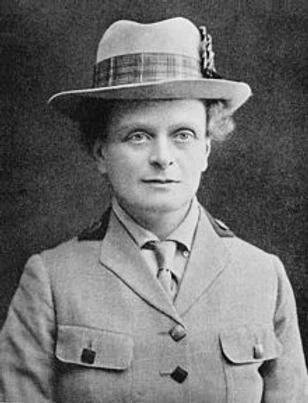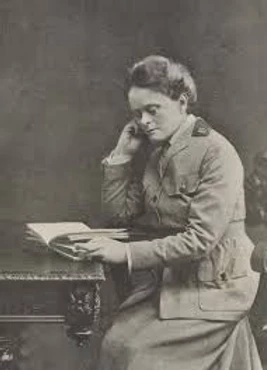Dr Elsie Inglis: Surgeon, Suffragist and Hero

Early life
From an early age, Elsie Inglis was taught to fight against injustice and inspired with a determination to pursue her dreams. Born on the 16th August 1864, Elsie Maude Inglis spent her early years in India, where her father was employed in the Indian Civil Service. He was a strong supporter of women’s rights and believed they should have equal access to education.
Training
At the age of 14, her family returned to Edinburgh. After completing her secondary education here, she attended a course for female etiquette in Paris. She returned to Scotland with a renewed passion for studying medicine in 1886 and joined the then revolutionary Edinburgh School of Medicine for Women under Dr Sophia Jex-Blake, who taught her gynecology. She then spent 3 years studying with Sir William McEwen at the ,who first developed her interest in surgery. She qualified as a doctor in 1892 and completed her training in a hospital in what would later become the Elizabeth Garrett Anderson Hospital for Women in London and other Dublin’s hospital for women. It was at this point that Inglis was shocked by the appalling conditions that female patients were treated under, and decided that a hospital run by women for women was the best possible solution.
She returned to Edinburgh in 1894, to care for her sick father until his death and graduated from the University of Edinburgh in 1899, once it became possible for women to study in universities. After obtaining her degree, she perfected her technique, travelling to Austria and the United States. She eventually returned once again to Edinburgh in 1904, where she created a small maternity hospital for Edinburgh’s poor in the Royal Mile, staffed entirely by women. This has later become the Elsie Maude Inglis Memorial Hospital and was one of the main centers for obstetrics training. She also accepted a consultant position at Bruntsfield Hospital, which was previously only for women.

Inglis had for some time been a member of the National Union of Women’s Suffrage Societies, and in 1906 she launched the Scottish Women’s Suffragette Federation, fighting not only for the women’s vote but for equal right in education and the medical career.
World War I
At the outbreak of war in 1914, Inglis suggested the creation of medical units staffed by women which could provide aid to British forces on the Western Front. She was rejected by the British War Office, the Red Cross and the Royal Army Medical Corps, with the explanation that a woman’s role was at home.
“My good lady, please go home and sit still”
Despite these rejections, Inglis founded the Scottish Women’s Hospitals Committee, with the help of several feminist societies which helped access to funds. The French Government was less negative, and by December 1914, Inglis’s first medical unit staffed wholly be women were setting up the 200 bed Abbaye de Royaumont hospital. Inglis wanted to demonstrate to the world that women had the ability and potential to take roles that society had previously prevented.
She spent her time in France, Rusia and Serbia, where she was briefly imprisoned in 1915 by Austrian forces. She was released by the intervention of the United States, which at the time was still neutral. She was awarded the “White Eagle Award” by Serbia, as she helped during the Tyfus epidemic that shocked the country in 1906, killing up to 16% of the population. Elsie Inglis was dearly loved by the Serbian people, who fondly called her the “Scottish mother of Serbia”, and she equally loved them, referring to them as “my dear Serbians” in several of her letters.
Her legacy
Inglis’s health forced her to return to Britain in 1917. She suffered from cancer but had previously continued to lead the women’s medical unit, even though she could no longer take part in surgery. She died on November 26 1917, just one day after setting foot in Newcastle upon Tyne.
Her legacy continues up to this day, inspiring male and female students alike to fight for their dreams and their patients. Scottish Women’s Hospitals Committee sent over 1000 women doctors, nurses, orderlies and drivers to war zones across Europe. They oversaw the creation of four Scottish Women’s Hospitals, which had much lower levels of death from the disease than the more traditional military hospitals than in operation. And they also sent fourteen medical units to serve in areas as diverse as France, Serbia, Corsica, Salonika, Romania, Russia and Malta. In 1925, the Elsie Inglis Memorial Hospital was found and worked until 1992 as a maternity center.
Author- Alba Saenz de Villaverde
References:
Es.wikipedia.org. (2019). Elsie Inglis. [online] Available at: https://es.wikipedia.org/wiki/Elsie_Inglis [Accessed 13 Feb. 2019].
Rcpe.ac.uk. (2019). Elsie Inglis | Royal College of Physicians of Edinburgh. [online] Available at: https://www.rcpe.ac.uk/heritage/college-history/elsie-inglis [Accessed 13 Feb. 2019].
info@undiscoveredscotland.co.uk, U. (2019). Elsie Inglis: Biography on Undiscovered Scotland. [online] Undiscoveredscotland.co.uk. Available at: https://www.undiscoveredscotland.co.uk/usbiography/i/elsieinglis.html [Accessed 13 Feb. 2019].




Can you correct the information? Dr Inglis died in 1917, not 1907.
Thank you for picking that up!
I came across this just now
Sheffield Daily Telegraph – Tuesday 26 April 1921
Lady Champions Beaten Again.
Although the lady champions of Britain, Ireland, and the United States figured in the ladies’ meeting which was held at the West Hill course, Brookwood, Surrey, yesterday, none of them appeared in the prize list in the medal competition. The event was in aid of the fund to endow a hospital bed in memory of Dr. Elsie Inglis, a lady golfer who lost her life as the result of war service. The entry fees received from the 128 competitors go to the fund.
The result of the handicap event, was that Miss Horricks ……